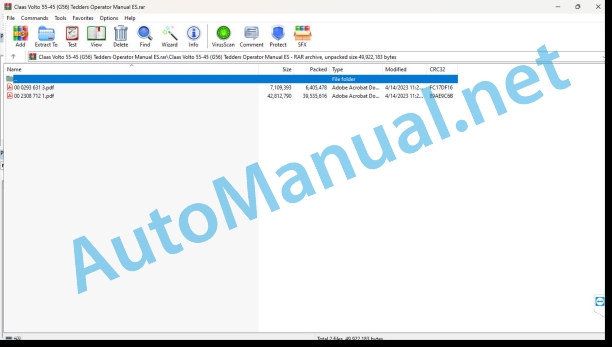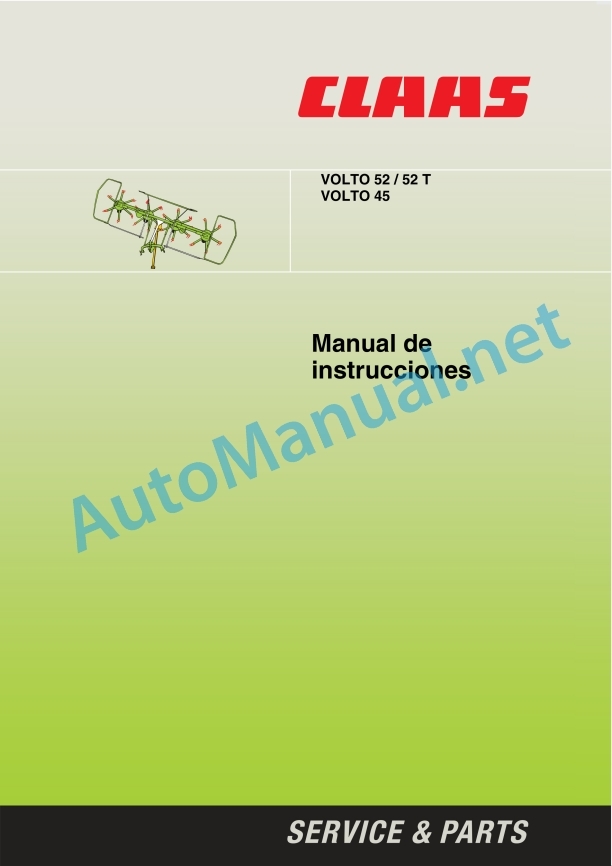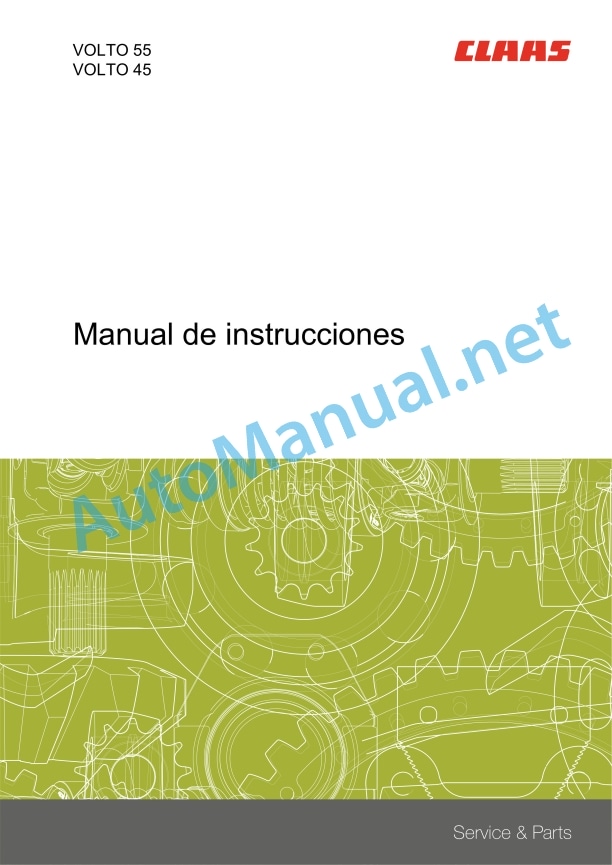Claas Volto 55-45 (G56) Tedders Operator Manual ES
$50.00
- Model: Volto 55-45 (G56) Tedders
- Type Of Manual: Operator Manual
- Language: ES
- Format: PDF(s)
- Size: 43.8 MB
File List:
00 0293 631 3.pdf
00 2308 712 1.pdf
00 0293 631 3.pdf:
1. Introduction
Introduction
3 Prologue
Pay special attention
Identification plate
4 Security measures
Use according to prescriptions
General safety and accident prevention rules
Attached devices
Hooked devices
Operation with power take-off shaft
Hydraulic system
Maintenance
noise level
Warning and danger signs
Safety decals with warning symbols
5 Technical data
VOLTO 52 T
Method of calculating axle load, minimum ballast and total weight
6 Assembly
Loading and unloading of the machine
Assembling the machine for the first time
7 Before start-up
Before commissioning, check and take into account!
Three-point support (VOLTO 52 / 45)
Lance (VOLTO 52 T)
hitch bar
Shooting pendulum
articulated axle
Adjust the length
Support leg
Hydraulic system
Electric connection
Traction wire rope
Machine stop
Before transportation
Highway driving
8 Management
Application
Work position
Transport position
Head position
Lowering the machine at rest
Lifting during tight curves and reversing
Dispersion angle variation
Wheel position
Working height adjustment
Prong position
Scattered
Commissioning the turner
Extreme application conditions
Application possibilities
Row dispersal
Windrow (with windrow gear)
Turn swaths (with swath gear)
Field boundary clearing (standard equipment)
Picking up the edge of the field with a limiting tarp (Additional equipment)
Adjust the limitation canvas
Flip with limitation canvas (Additional Equipment)
Additional equipment
Windrower gear (only VOLTO 52 / 45) R03 / 0400
Insurance against loss of tines
Demarcation tarpaulin – mechanically tiltable R03 / 0300
Demarcation canvas – hydraulically tiltable R03 / 0320
Rear wheel three-point support (only VOLTO 52 / 45)
Insert fork kit
Hydraulic connecting parts for tractor
9 Maintenance
Important maintenance instructions
Hydraulic system
Protective devices (Protective stirrup)
Wheels / tires
Windrower gear (Additional equipment)
articulated axle
spring adjustment
Pull spring (VOLTO 52 T only)
Bolted Assemblies
Elastic tines fixing screws
Connection elements
Hydraulic system
Hydraulic hoses
Conservation during winter
10 Greasing scheme
Security measures
Lubricants
00 2308 712 1.pdf:
VOLTO 55VOLTO 45
1. Introduction
1.1 General information
1.1.1 Validity of the manual
1.1.2 Information relating to this instruction manual
1.1.3 Symbols and indications
1.1.4 Optional equipment
1.1.5 Qualified specialized workshop
1.1.6 Maintenance instructions
1.1.7 Information regarding warranty
1.1.8 Spare parts and technical questions
1.2 Proper application of the machine
1.2.1 Proper machine application
1.2.2 Logically foreseeable inappropriate application
2 Security
2.1 Recognize warning signs
2.1.1 Danger symbols
2.1.2 Keyword
2.2 Safety instructions
2.2.1 Meaning of the instruction manual
2.2.2 Observe graphic danger symbols and alarm indications
2.2.3 Requirements for all people working with the machine
2.2.4 Children in danger
2.2.5 Danger zones
2.2.6 Position yourself between the tractor and the machine
2.2.7 Accompanying persons
2.2.8 Couple the tractor with the machine
2.2.9 Risk of injury due to rotating shafts
2.2.10 Construction changes
2.2.11 Optional equipment and spare parts
2.2.12 Control of the machine in operation
2.2.13 Use only after correct start-up
2.2.14 Technical status
2.2.15 Danger due to machine breakdowns
2.2.16 Comply with technical limit values
2.2.17 Danger due to coasting parts
2.2.18 Keep protective devices operational
2.2.19 Personal protective equipment
2.2.20 Wear appropriate clothing
2.2.21 Remove dirt and loose objects
2.2.22 Prepare the machine for road traffic
2.2.23 Dangers when driving on the road and in the countryside
2.2.24 Park the machine safely
2.2.25 Parking without supervision
2.2.26 Unsuitable consumables
2.2.27 Safe handling of consumables and auxiliary materials
2.2.28 Environmental protection and waste disposal
2.2.29 Fire protection
2.2.30 Liquids under pressure
2.2.31 Work only on the stopped machine
2.2.32 Maintenance work and repair work
2.2.33 Machine parts and lifted loads
2.2.34 Danger from welding work
2.3 Safety instructions on the machine
2.3.1 Structure of graphic hazard symbols
2.3.2 Position of warning symbols on the machine
3 Machine Description
3.1 Summary and operation
3.1.1 Machine overview
3.1.2 Machine operating mode
3.2 Optional equipment
3.2.1 Union fork kit*
3.2.2 Anti-loss safety for tines ø 9.5 mm*
3.2.3 Mechanical limiting canvas*
3.2.4 Hydraulic limiting canvas*
3.2.5 Feeler wheel*
3.2.6 Spare wheel 16×6.5-8*
3.2.7 Gear for making rows at night*
3.2.8 Warning signs*
3.2.9 Illuminated warning signs*
3.2.10 Warning signs Italy*
3.2.11 Legal equipment France*
3.3 Identification plates and vehicle identification number
3.3.1 Machine identification plate
3.4 Machine information
3.4.1 Adhesive on the machine
4 Control and display instruments
4.1 Control elements
4.1.1 Pull rope for transport insurance
5 Technical data
5.1 VOLT 55
5.1.1 Dimensions
5.1.2 Weights
5.1.3 Tractor requirements
5.1.4 Version
5.1.5 Tire measurements
5.1.6 Tire air pressure
5.1.7 Acoustic intensity level
5.1.8 Lubricants
5.2 VOLT 45
5.2.1 Dimensions
5.2.2 Weights
5.2.3 Tractor requirements
5.2.4 Version
5.2.5 Tire measurements
5.2.6 Tire air pressure
5.2.7 Acoustic intensity level
5.2.8 Lubricants
Peparation of the machine
6.1 Turn off the machine and secure it
6.1.1 Shut down and secure the machine and tractor
6.1.2 Secure the lifted machine
6.2 Prepare the tractor
6.2.1 Check the tractor ballast
Calculate the minimum front ballast
Calculate the minimum rear ballast
Calculate the actual load on the front axle
Calculate the actual total weight
Calculate the actual load on the rear axle
Calculation table
6.2.2 Check the tractor power take-off protection device
6.3 Adapt the machine
6.3.1 Cardan shaft – check the length
6.3.2 Adapt the length of the cardan shaft
6.3.3 Assemble the cardan shaft to the machine
6.4 Hooking up the machine
6.4.1 Attach the three-point support
6.4.2 Assemble the cardan shaft
6.4.3 Insert the lighting cable*
6.4.4 Attach the hydraulic hose
6.4.5 Attach the hydraulic hose for the limitation canvas*
6.4.6 Raise the support legs
6.4.7 Save shims
6.5 Unhooking the machine
6.5.1 Remove the support leg
6.5.2 Put the shims underneath
6.5.3 Remove the lighting cable*
6.5.4 Disconnect the hydraulic hose
6.5.5 Detach the hydraulic hose for the hydraulic limitation canvas*
6.5.6 Dismantle the cardan shaft
6.5.7 Unhook the three-point support
6.6 Prepare for road traffic
6.6.1 Fold the machine into transport position
6.6.2 Check before driving on the road
6.7 Prepare for use at work
6.7.1 Deploy the machine to the working position
6.7.2 Adjust the spreading angle
6.7.3 Adjust the tines
6.7.4 Adjust the limiting canvas*
6.7.5 Adjusting the working height with feeler wheel*
6.8 Load the machine
6.8.1 Lift the machine
7 Management
7.1 Driving on the road
7.1.1 Circulation on public roads
7.2 Settings for use at work
7.2.1 Adjust spreading
7.2.2 Adjust the working height
7.2.3 Change the position of the cardan shaft
7.3 Use at work
7.3.1 Fold the machine into transport position
7.3.2 Deploy the machine to the working position
7.3.3 Using the machine
7.3.4 Spread
7.3.5 Flipped
7.3.6 Row spreading
7.3.7 Night rows
7.3.8 Row turning
7.3.9 Deploy the limiting canvas*
7.3.10 Fold the limiting canvas*
7.3.11 Turning with limiting canvas*
8 Incident and solution
8.1 Summary of incidents
8.1.1 Summary of incidents on the machine
8.2 Chassis
8.2.1 Change wheel on the rotor chassis
8.2.2 Change the feeler wheel*
8.3 Electrical and electronic system
8.3.1 Defective bulbs*
9 Maintenance
9.1 Summary of maintenance intervals
9.1.1 Before harvest
9.1.2 After the first 10 hours of service
9.1.3 After the first 50 hours of service
9.1.4 Every 8 hours of service or daily
9.1.5 Every 50 hours of service
9.1.6 Every 500 hours of service or annually
9.1.7 Every 5 years
9.1.8 After harvest
9.2 Gearbox
9.2.1 Check the tightness of the gear
9.2.2 Change main gear lubricant
9.2.3 Change the rotor gear lubricant
9.2.4 Check the gear oil level for night rowing*
9.2.5 Change night swath gear oil*
9.3 Clutches
9.3.1 Check the overload clutch
9.4 Cardan shaft
9.4.1 Maintenance of cardan shafts
9.5 Chassis
9.5.1 Check tire pressure
9.5.2 Check the wheel nuts on the rotor chassis
9.5.3 Check the wheel nut on the feeler wheel*
9.6 Drives
9.6.1 Grease PERMALINK finger couplings
9.7 Hydraulic installation
9.7.1 Check the hydraulic hoses
9.7.2 Check the pressure accumulator*
9.8 Pick holder
9.8.1 Check the tines
9.9 Assembled parts and machine casing
9.9.1 Clean the machine
9.9.2 Maintain the machine
9.9.3 Check the fixing material
9.10 Greasing scheme
9.10.1 Grease the lubrication points every 8 hours of service
9.10.2 Grease the lubrication points every 50 hours of service
10 Decommissioning and waste disposal
10.1 General information
10.1.1 Decommissioning and waste disposal
11 EC declaration of conformity
11.1 VOLT 55 / 45
11.1.1 EC declaration of conformity
12 Technical dictionary and abbreviations
12.1 Terms and explanations
12.1.1 Technicalities
12.1.2 Abbreviations
John Deere Repair Technical Manual PDF
John Deere Repair Technical Manual PDF
John Deere Repair Technical Manual PDF
John Deere Transmission Control Unit Component Technical Manual CTM157 15JUL05
John Deere Repair Technical Manual PDF
John Deere Diesel Engines POWERTECH 2.9 L Component Technical Manual CTM126 Spanish
John Deere Repair Technical Manual PDF
John Deere Repair Technical Manual PDF
John Deere Parts Catalog PDF
John Deere Harvesters 8500 and 8700 Parts Catalog CPCQ24910 Spanish
John Deere Repair Technical Manual PDF
John Deere PowerTech M 10.5 L and 12.5 L Diesel Engines COMPONENT TECHNICAL MANUAL CTM100 10MAY11
John Deere Repair Technical Manual PDF
John Deere Repair Technical Manual PDF
John Deere Diesel Engines PowerTech 4.5L and 6.8L – Motor Base Technical Manual 07MAY08 Portuguese






















